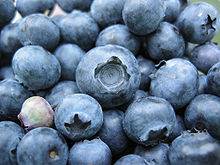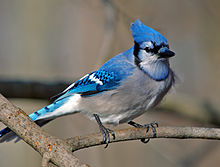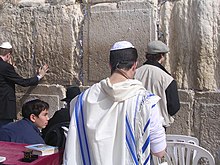Blue
Blue (RGB)
#0000FF
Blue (CMYK)
#333399
Blue (NCS) S 2060-B
#0087BD
Blue (Munsell) 5B
#0093AF
| Blue | |
|---|---|
| Spectral coordinates | |
| Wavelength | 440–490 nm |
| Frequency | ~680–610 THz |
| Common connotations | |
| ice, water, sky, sadness, winter, royalty, boys, cold, calm, magic, trueness, conservatism (universally), liberalism (US), and capitalism | |
| Source | [Unsourced] |

Blue is a colour, the perception of which is evoked by light having a spectrum dominated by energy with a wavelength of roughly 440–490 nm. It is considered one of the additive primary colours. On the HSV Colour Wheel, the complement of blue is yellow; that is, a colour corresponding to an equal mixture of red and green light. On a colour wheel based on traditional colour theory (RYB), the complementary colour to blue is considered to be orange (based on the Munsell colour wheel).[1] The English language commonly uses "blue" to refer to any colour from navy blue to cyan. The word itself is derived from the Old French word bleu.
Various definitions of blue
The definition of the color blue depends on what color system is used to define the color blue. The definition of blue according to four of the major color systems is shown below.
Blue (RGB)
| Blue (RGB) | |
|---|---|
| Hex triplet | #0000FF |
| sRGBB (r, g, b) | (0, 0, 255) |
| HSV (h, s, v) | (240°, 100%, 100%) |
| CIELChuv (L, C, h) | (32, 131, 266°) |
| Source | HTML/CSS |
| B: Normalized to [0–255] (byte) | |

The blue color used as a primary in the RGB color system, X11 blue, is shown at right. This tone of blue is one of the three additive primary colors, along with red and green. The three additive primaries in the RGB color system are the three colors of light chosen such as to provide the maximum gamut of colors that are capable of being represented on a computer or television set.
Blue (CMYK)
| Blue (CMYK) | |
|---|---|
| Hex triplet | #333399 |
| sRGBB (r, g, b) | (51, 51, 153) |
| HSV (h, s, v) | (240°, 67%, 60%) |
| CIELChuv (L, C, h) | (28, 73, 266°) |
| Source | CMYK |
| B: Normalized to [0–255] (byte) | |

The blue color used as a secondary in the CMYK color system used in printing, is the tone of blue that is achieved by mixing process (printer's) cyan and process (printer's) magenta in equal proportions. It is displayed at right.
The purpose of the CMYK color system is to provide the maximum possible gamut of color reproducible in printing.
The color indicated is only approximate as the colors of printing inks may vary.
Blue (NCS)
| Blue (NCS) | |
|---|---|
| Hex triplet | #0087BD |
| sRGBB (r, g, b) | (0, 135, 189) |
| HSV (h, s, v) | (197°, 100%, 74%) |
| CIELChuv (L, C, h) | (53, 65, 237°) |
| Source | sRGB approximation to NCS 2060-B[2] |
| B: Normalized to [0–255] (byte) | |

The blue color used as a primary in the NCS or Natural Color System is shown at right (NCS 2060-B). The Natural Color System is a color system based on the four unique hues or psychological primary colors red, yellow, green, and blue. These hues are an average derived from individual variations recorded by different observers. The NCS is based on the opponent process theory of vision.
The “Natural Color System” is widely used in Scandinavia.
Blue (Munsell)
| Blue (Munsell) | |
|---|---|
| Hex triplet | #0093AF |
| sRGBB (r, g, b) | (0, 147, 175) |
| HSV (h, s, v) | (190°, 100%, 69%) |
| CIELChuv (L, C, h) | (56, 52, 220°) |
| Source | Munsell Color Wheel |
| B: Normalized to [0–255] (byte) | |

The blue color used as a primary in the Munsell color system (Munsell 5B) is shown at right. The Munsell color system is a color space that specifies colors based on three color dimensions: hue, value (lightness), and chroma (color purity), spaced uniformly in three dimensions in the elongated oval at an angle shaped Munsell color solid according to the logarithmic scale which governs human perception. In order for all the colors to be spaced uniformly, it was found necessary to use a color wheel with five primary colors--red, yellow, green, blue, and purple.
The Munsell colors displayed are only approximate as they have been adjusted to fit into the sRGB gamut.
Etymology and linguistic definitions
The modern English word blue comes from Middle English bleu or blewe, from Old French bleu, bleve, blöe, a word of Germanic origin (Frankish or possibly Old High German blāo, "blue"). Bleu replaced Old English blāw "blue" and blǣwen "light blue". The root of all these variations is Proto-Germanic blǣwaz, from Proto-Indo-European *bhlāw-, *bhlēw- "light-coloured, yellow, grey, blue", from *bhel- "to shine, be light or bright", also the root of Old Norse blār and the modern Icelandic blár, and the Scandinavian word blå, which can also refer to other non blue colours. A Scots and Scottish English word for "blue-grey" is blae, from the Middle English bla ("dark blue", from Old Norse blār). Also related is the English word blee meaning "colour, complexion". Ancient Greek lacked a word for blue and Homer called the colour of the sea "wine dark", except that the word kyanos (cyan) was used for dark blue enamel. As a curiosity, blue is thought to be cognate with blond, blank and black through the Germanic word. Through a Proto-Indo-European root, it is also linked with Latin flavus ("yellow"; see flavescent and flavine), with Greek phalos (white), French blanc (white, blank) (borrowed from Old Frankish), and with Russian белый, belyi ("white," see beluga), and Welsh blawr (grey) all of which derive (according to the American Heritage Dictionary) from the Proto-Indo-European root *bhel- meaning "to shine, flash or burn", (more specifically the word bhle-was, which meant light coloured, blue, blond, or yellow), whence came the names of various bright colours, and that of colour black from a derivation meaning "burnt" (other words derived from the root *bhel- include bleach, bleak, blind, blink, blank, blush, blaze, flame, fulminate, flagrant and phlegm).
In the English language, blue may refer to the feeling of sadness. "He was feeling blue". This is because blue was related to rain, or storms, and in Greek mythology, the god Zeus would make rain when he was sad (crying), and a storm when he was angry. Kyanos was a name used in Ancient Greek to refer to dark blue tile (in English it means blue-green or cyan).[3] The phrase "feeling blue" is linked also to a custom among many old deepwater sailing ships. If the ship lost the captain or any of the officers during its voyage, she would fly blue flags and have a blue band painted along her entire hull when returning to home port.[4]
Many languages do not have separate terms for blue and or green, instead using a cover term for both (when the issue is discussed in linguistics, this cover term is sometimes called grue in English).
Gallery


In science
Pigments
Traditionally, blue has been considered a primary colour in painting, with the secondary colour orange as its complement.
Blue pigments include azurite (Cu
3(CO
3)
2(OH)
2), ultramarine (Na8-10Al
6Si
6O
24S2-4), cerulean blue (primarily cobalt (II) stanate: Co
2SnO
4), cobalt blue (cobalt(II) aluminate: CoAl
2O
4), and Prussian blue (milori blue: primarily Fe
7(CN)
18).
Scientific natural standards for blue
- Emission spectrum of Cu2+
- Electronic spectrum of aqua-ions Cu(H
2O)2+
5
Fungi

Animals


- When an animal's coat is described as "blue", it usually refers to a shade of grey that takes on a bluish tint, a diluted variant of a pure black coat.[citation needed] This designation is used for a variety of animals, including dog coats, some rat coats, cat coats, some chicken breeds, some horse coat colours and rabbit coat colours. Some animals, such as giraffes and lizards, also have blue tongues.
In culture
Symbolic language
- In the English language, blue often represents the human emotion of sadness, e.g. "He was feeling blue". In German, on the other hand, to be "blue" (blau sein) is to be drunk. This derives from the ancient use of urine (which is produced copiously by the human body after drinking alcohol) in dyeing cloth blue with woad or indigo.[5] It may also be in relation to rain, which is usually regarded as a trigger of depressive emotions.[6]
- Conversely blue, a very popular colour[7] can represent happiness and optimism[8] as days with clearer, blue skies tend to be considered times where these emotions are more easily expressed. Many artistic contributions have been made referencing clear days with blue skies as part of the happiness or as a symbolism of the happiness the artist felt, such as Tony Bennett's Put on a Happy Face.[9] If this were untrue there would obviously be more complaints about days with clear blue skies.
- Blue is commonly used in the Western hemisphere to symbolize the male gender in contrast to pink used for females.
National colours


- Azzurro, a light blue, is the national colour of Italy (from the livery colour of the former reigning family, the House of Savoy).
- Blue is the national sports colour for India, as it denotes secularism.[citation needed]
- Blue is the national colour used on flags of several countries surrounded by seas or oceans such as Australia and Europe, though not necessarily with this interpretation in mind.
- Blue and white are the national colours of Scotland, Argentina, El Salvador, Finland, Greece, Guatemala, Honduras, Israel, Micronesia, Nicaragua, and Somalia as well as of the United Nations using a light shade of blue symbolising peace.
- Blue and yellow are the national colours of Barbados, Kazakhstan, Palau, Sweden, and Ukraine, and along with green, of Brazil, and along with red, of Chad, Colombia, Ecuador, Moldova, Romania, and Venezuela.
- Blue, white and yellow are the national colours of Bosnia and Herzegovina, Kosovo and Uruguay.
- Blue and red are the national colours of Haiti and Liechtenstein, and (along with white) of Australia, Cambodia, Costa Rica, Chile, Croatia, Cuba, the Czech Republic, the Dominican Republic, France, Iceland, North Korea, Laos, Liberia, Luxembourg, Myanmar, Nepal, the Netherlands, New Zealand, Norway, Panama, Paraguay, Russia, Samoa, Serbia, Slovakia, Slovenia, Thailand, the United Kingdom, and the United States
- Blue, white and black are the national colours of Estonia.[10]
Mysticism
Politics
- The Blue House is the residence of the President of South Korea[12].
- Blue has been associated with a variety of political positions, often differentiated from communist red or anarchist black. During the revolt in the Vendée against the French Revolution, blues stood for the revolutionary forces, and white for the counter-revolutionaries. Later movements like the Breton blues used the colour to signify allegiance to the ideals of the revolution.
- The blueshirts was a quasi-fascist political organisation active in Ireland during the 1930s (the name comes from the fact that St. Patrick's Blue is one of the traditional colours of Ireland).
- Blue is the colour of the Conservative Party in Britain and Conservative Party of Canada. In the United States it has become fashionable since the 2000 presidential election to link the Democratic Party as "blue" and the Republican Party as "red" (especially in reference to "red states and blue states"). In Brazil, blue states are the ones in which the Social Democratic Party has the majority, in opposition to the Workers' Party, usually represented by red.

Religion
- Blue is associated in Christianity generally and Catholicism in particular, with the Virgin Mary.
- Blue in Hinduism: Many of the gods are depicted as having blue-coloured skin, particularly those associated with Vishnu, who is said to be the Preserver of the world and thus intimately connected to water. Krishna and Ram, Vishnu's avatars, are usually blue. Shiva, the Destroyer, is also depicted in light blue tones and is called neela kantha, or blue-throated, for having swallowed poison in an attempt to turn the tide of a battle between the gods and demons in the gods' favour.
- Blue in Judaism: In the Torah,[13] the Israelites were commanded to put fringes, tzitzit, on the corners of their garments, and to weave within these fringes a "twisted thread of blue (tekhelet)".[14] In ancient days, this blue thread was made from a dye extracted from a Mediterranean snail called the hilazon. Maimonides claimed that this blue was the colour of "the clear noonday sky"; Rashi, the colour of the evening sky.[15] According to several rabbinic sages, blue is the colour of God's Glory.[16] Staring at this colour aids in mediation, bringing us a glimpse of the "pavement of sapphire, like the very sky for purity", which is a likeness of the Throne of God.[17] (The Hebrew word for glory.) Many items in the Mishkan, the portable sanctuary in the wilderness, such as the menorah, many of the vessels, and the Ark of the Covenant, were covered with blue cloth when transported from place to place.[18]
- Blue in Islam: In verse 20:102 of the Qur’an, the word زرق zurq (plural of azraq 'blue') is used metaphorically for evildoers whose eyes are glazed with fear, as if the sclera is filmed over with a bluish tint.
Symbolism
- In Thailand, blue is associated with Friday on the Thai solar calendar. Anyone may wear blue on Fridays and anyone born on a Friday may adopt blue as their colour. The Thai language, however, is one that has had trouble distinguishing blue from green. The default word for Blue was recently สีน้ำเงิน literally, the colour of silver, a poetical reference to the silvery sheen of the deep blue sea. It now means Navy Blue, and the default word is now สีฟ้า literally, the colour of the sky.[19]
Variations
Please see the article variations of blue.
See also
- Blue Flag
- Blue movie
- Blue ribbon
- Blue Screen of Death
- Distinguishing "blue" from "green" in language
- Engineer's blue
- Lapis lazuli, a blue stone
- List of colours
- Non-photo blue
- St. Patrick's Blue
- Turquoise
- Variations of blue
References
- ^ "Glossary Term: Color wheel". Sanford-artedventures.com. Retrieved 2009-04-14. [dead link]
- ^ The sRGB values are taken by converting the NCS color 2060-B using the “NCS Navigator” tool at the NCS website.
- ^ Merriam-Webster's Ninth New Collegiate Dictionary Springfield, Mass.:1984--Merriam-Webster Page 319
- ^ "US Navy - origins of Navy Terminology"
- ^ Heller, Eva. Wie Farben wirken: Farbpsychologie, Farbsymbolik, kreative Farbgestaltung. Berlin: Rowohlt, 2004.
- ^ Top 10 weather complaints
- ^ Preferences - Favorite Color
- ^ Psychology of Color
- ^ "Put on a Happy Face" lyrics
- ^ "Estonia in brief: National Symbols" at Estonica website Estonica.org
- ^ Stevens, Samantha. The Seven Rays: a Universal Guide to the Archangels. City: Insomniac Press, 2004. ISBN 1-894663-49-7 pg. 24
- ^ Cheong Wa Dae / The Blue House,
The Main Building and its two annexes are covered with a total of 150,000 traditional Korean blue roof tiles (hence, the name "Blue House" is also commonly used when referring to Cheongwadae).
- ^ Numbers 15:38.
- ^ Tekhelet.com, the Ptil Tekhelet Organization
- ^ Mishneh Torah, Tzitzit 2:1; Commentary on Numbers 15:38.
- ^ Numbers Rabbah 14:3; Hullin 89a.
- ^ Exodus 24:10; Ezekiel 1:26; Hullin 89a.
- ^ Numbers 4:6-12.
- ^ Glenn Slayden. "Thai language". thai-language.com. Retrieved 2009-04-14.


